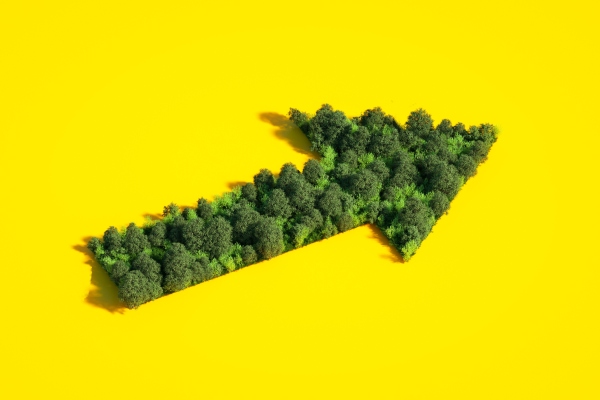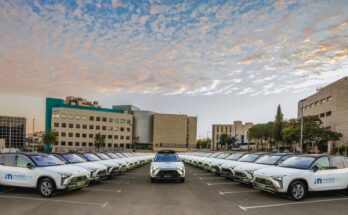[ad_1]
Arvind is co-head of Mayfield's engineering biology practice and founder and venture advisor of IndieBio. He was the first to invest in organic breakout companies such as Geltor, Synthex, Prime Roots, NotCo, Prellis, New Culture, DNA Lite and Memphis Meats.
The climate over the past decade has been unprecedented in many ways, none of which is good.
California forest fires devoured entire cities; Thousands of miles away, New Yorkers breathe in the ashes. Flash floods are wreaking havoc across Europe and Japan. We all see the videos on YouTube and CNN. And we shrug our shoulders.
The recently published report of the 6th Intergovernmental Panel on Climate Change concluded that human-made climate change is happening faster than we thought and called it a "code red alert". At just 2 degrees warmer than today, an estimate predicts more than 300,000,000 climate-related deaths worldwide by 2100. And that's the optimistic estimate. Global warming is overwhelming and seems impossible to fix. What the hell can we do?
Like many of you, I am an optimist. In the past, humanity has often reached the limits of nature and has overcome them with technology. We have always adapted to our surroundings; The change in our technology and behavior due to environmental changes is part of our history.
Regulation will help businesses incentivize cleanup, but only technology can solve the persistent problem of giving us what we want in a sustainable way. Thoughtless consumption brought us climate change, but it is also true that mindless consumption can get us out of it.
How do we use capitalism to eliminate greenhouse gas emissions worldwide? Follow the coal. This leads us to the three main bottlenecks on the way to net zero carbon emissions.
What follows is necessarily a general overview of huge and complex industries. I have intentionally left out granular details so that we can address the overarching issues.
Electrification: 36 gigatons of CO2 emitted
TAM: $ 7 trillion
Global carbon usage is highest in energy production as we burn coal, oil and natural gas to power our cars, cities and industries (yes, coal will still be mined and burned in 2021). That is a whopping 36 gigatons of CO2 emissions per year. Why are we still burning coal? It is cheap, needs-based, universal, portable, an order of magnitude more efficient than lithium-ion batteries and much safer.
But it has to be eliminated very soon.
The IPCC report found that 89% of global CO2 emissions come from fossil fuels. In addition, it tells us that we have to cut these emissions in half over the next ten years or risk an increase in average global temperatures of 1.5 degrees Celsius.
At present, wind and sun cannot produce 100% electricity; The energy generated must be stored and not, as it is today, disposed of unused. There are many ways to produce clean energy today, including nuclear, tidal, hydropower, geothermal, and other means. The merger progresses every year.
Civilization was born next to the sheep and cows, but 10,000 years later the sheep, cow and pig are killing us. They emit 10% of the world's greenhouse gases and the global demand for meat is skyrocketing.
We will need more than double today's clean energy production to meet growing demand. But unless we can store this energy and use it in cars, boats, planes, and more, clean energy production will not eliminate the need for oil and coal. Energy storage is the greatest bottleneck for a global electrical industry. We need bigger, safer, cleaner batteries that can be used anywhere from the mains to our cars to our homes and leave the lights on when we need them most.
You and I are not going to buy these batteries, but they will power everything we buy. From cars to cargo ships to the airplanes that carry us, they will all be electric at some point. Boeing has just ordered 100 electric planes from Heart Aerospace, and investments have been made in them. The world's first electric cargo ship, the Yara Birkeland, built by Marin Teknikk, is soon to make its maiden voyage.
There are no fewer than a dozen electric aircraft companies and six dozen electric vehicle companies. However, the bottleneck for these efforts to scale and replace all fossil fuel planes, ships, and automobiles with equal power is a modest battery that can deliver sustained high performance over a long period of time. Without this fundamental further development, these companies will remain in the conceptual stage for a long time to come.
Unfortunately, lithium-based battery technology still only has a tenth of the maximum energy density of gasoline (that is around 50 megajoules per kilogram). It's not enough. The closest thing to lithium-ion technology is the lithium-air battery, which has a theoretical energy density of 40 megajoules per kilogram, but for this new electrolytes have to be invented. As Chuck Yeager breaks the sound barrier to usher in the supersonic age, we need to break that density barrier to power our green future.
Recent studies have shown that melanin, our skin pigment, is also showing great promise as a potent cathode that can make rechargeable sodium batteries possible. This would enable large-scale “salt” batteries that can be used to create a safe and clean grid storage solution. Researchers have also used viruses to create nanosheets of various elements to create higher powered cathodes. Other lines of research have shown that batteries powered by enzymatic catalysts could potentially use sugar water to slowly charge your car or home with bio-electricity. None of the above solutions will be on the market within a decade; all are at the research stage.
The winners of the electrification wars will pool these technologies across industries and provide consumers with a seamless, wonderful experience. From fast wireless charging of electronics and vehicles to self-adapting national power grids, an electrified world will be quieter, more efficient and cleaner. I am excited about the prospect of living in a fully electric world.
Rematerialization: 10.2 gigatons emitted
TAM: $ 12 trillion
Every item in the room you are sitting in was not produced sustainably and smells of CO2 emissions. Cement floor, sofa, dining table, desk, refrigerator, sink, chairs, even the walls all contribute to climate change. Consumers have no choice; They cannot buy green, and we have to change that.
Only durable goods and our built environment cause more than 10.2 gigatons of CO2 emissions each year, or almost a third of the total emissions. The heights of dirty industry must be overthrown and rebuilt from scratch with a new goal in mind: Sustainable production for hundreds of years.
Cement
Worldwide cement production emits almost 2.5 gigatons of carbon dioxide per year. There are dozens of green cement companies currently trying different approaches to avoiding CO2 emissions from cement and concrete. At IndieBio, I invested in Carbix, a company that captures carbon emissions and uses them to make olivine cement. You made a few bricks and are years away from the market.
The main barrier for most green cement formulators is evidence of equivalent structural performance. Scaling is expensive. However, in the next few years some companies will come onto the market that promise greener concrete.
steel
The production of steel and aluminum is energy-intensive. In fact, many commodity traders refer to aluminum as “solid energy”. Providing our foundries with clean energy and reducing their carbon consumption will help prevent 8% of emissions.
wood
Trees are our biggest carbon sinks. They suck in CO2 from the air and breathe out the oxygen that we breathe. So why are we still cutting them off?
Hopefully we won't have to do that any more soon. Companies are using flax and other natural fibers to make bio-composites that are stiffer than steel and lighter than wood, or are developing sustainable bamboo for exterior building panels. Others experiment with mushroom mycelium to grow entire buildings.
Leather and fabrics
Cows contribute 7.1 gigatons of CO2 per year to global warming, a full 14.5% of the total. Not only do we eat them, we use their skin a lot. Leather is everywhere from shoes and couches to purses and clothing. We have to replace this material if we want to remove cows from our supply chain.
Fortunately, a dozen companies are making strides to get plastic and leather out of fashion. All of them are hugely popular with consumer companies that want to offer their consumers vegan and sustainable products.
Fabrics such as polyester are made from petrochemicals. Fermentation technologies are characterized by the use of algae or yeast as a factory to produce oils from sugar water. Fermentation is scalable and exists today while a newer technology called cell-free synthesis is applied to the same problems. We can count on new green materials in the next five years.
Industrial chemicals
Break open oil and you will be given a list of unpronounceable names that make a lot of our world. These chemicals are used in engines, antifreeze, cosmetics, and even food. In order to eliminate the need for oil, these products have to be replaced by fermentation, which converts sugar into chemicals.
The sugar can come from corn or even waste CO2 in chimneys. Cells don't have to live either, because cell-free synthesis allows the enzymes to do the job themselves. A large number of companies have started to recreate all of these chemicals through various fermentation and synthesis processes.
The rematerialization of our planet with sustainable, CO2-neutral sources can remove up to 10 gigatons of emissions from our economy. Our houses and everything in them will at some point become climate-neutral through rematerialization. I am happy to break this bottleneck in progress because it naturally leads to better products for everyone.
Food: 3.6 gigatons of CO2 emitted
TAM: $ 10 trillion
The first slide in a presentation I gave to explain the new food revolution showed cavemen with spears being torn to pieces by a giant prehistoric bear. The point? Protein is important enough to die for. When we switched from hunting to agriculture, our society was reorganized around cities and the division of labor.
Civilization was born next to sheep and cow, but 10,000 years later sheep, cow and pig are killing us. They emit 10% of the world's greenhouse gases and the global demand for meat is skyrocketing. For the past six years at IndieBio, I have invested in Clara Foods, Geltor, Memphis Meats (now Upside Foods), NotCo, and many others to reinvent agriculture through fermentation, herbal formulations, and cell-based culture.
These startups have reinvented well-known foods such as burgers, mayonnaise, popcorn shrimp, egg whites, poke bowls, sausages and chicken wings. As wealthy societies began to eat more processed foods, foods became products: cows became burgers, pigs became bacon, and chickens became nuggets. A legion of food-as-product companies have followed in their footsteps and there are entire conferences dedicated to them. “Food is hot” is an understatement in Silicon Valley.
Since I was part of the food revolution from the beginning, I am amazed at the extent of these revolutions once they really get going. I am also suspicious of revolutions that stall. Cell-based foods are slated to hit the market next year and consumers will be able to decide for themselves if the revolution is for them. The final shape and shape of the world as soon as the revolutions roll through society and become the new normal is therefore not easy to predict.
I'm a fan of history so I look back to see where we go next. My mom's recipe for chicken curry is a good place to start. It calls for bone-in chicken thighs, chopped. If I were to make a low-carbon, cruelty-free version of this recipe, I would have to use something other than chicken, but what? Are they just cell-based chicken nuggets? No, breaded chicken nuggets won't work, and neither will soy alternatives. Beyond curry? My mother would not approve of that.
Organic farming real food
So that agriculture can be reinvented for everyone, not just 1%, we have to produce food. Real, natural food. Steaks, chicken breasts and legs, meat on the bone and spare ribs. No processed version of these products, but ingredients for whole foods.
Food 3.0 is biofarming. Biofarming has to look for taste and healthy nutrition. Delicious food with no processing other than mom's recipe. Regenerative agriculture will enable carbon-neutral vegetables and crops if we can help farmers get their yields high enough to make a profit while a field is fallow for a season. Numerous technologies help with this.
We are not yet F & # 39; d
Bloomberg recently reported that from 2009 to 2019 there were over 5 million deaths worldwide from climate change-related events. That's 1 in 10 deaths on the planet. Since we don't track these statistics (we track heat stroke, drowning, landslides, suicide, and the things that directly kill us), nor any other impact like people without children and extreme anxiety, it's impossible to know the true extent of the misery climate change will bring . How far are we going to let this go before we all act? How many more will have to die?
The new normal does not have to be like this. Scientists can use their work to solve the paradox of carbon and production. Investors can choose to invest money in companies that are rebuilding our world to be smooth and green. And entrepreneurs can choose to start businesses that are reshaping our carbon economy for the greatest opportunity in history. The above roadmap represents the ability to eliminate almost all carbon emissions from human existence.
We are far from doomed. Together we will all build and fight for our future.
[ad_2]
Story continues…



